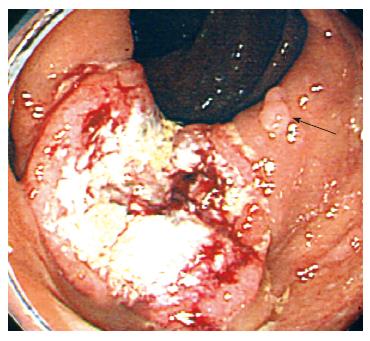Copyright
©2007 Baishideng Publishing Group Co.
World J Gastroenterol. Jun 21, 2007; 13(23): 3255-3258
Published online Jun 21, 2007. doi: 10.3748/wjg.v13.i23.3255
Published online Jun 21, 2007. doi: 10.3748/wjg.v13.i23.3255
Figure 1 A: Resected sigmoid colon.
The adenocarcinoma, 4.0 cm × 2.5 cm in size, shows ulcer formation with localized infiltrative growth. Multiple small polyps are seen in the resected colon (arrow); B: Well-differentiated adenocarcinoma located in the sigmoid colon (HE, × 100). High columnar tumor cells have proliferated to form papillary or tubular structures; C: Hyperplastic polyp located in the resected sigmoid colon (HE, × 100). The epithelial cells are arranged in a serrated fashion and have no atypical features.
Figure 2 A: Tubular adenoma located in the transverse colon (HE, × 100).
The lesion shows duct proliferation and cells that have mild nuclear atypia; B: Hyperplastic polyp located in the transverse colon (HE, × 200). Serrated ducts with no atypical features are observed; C: Hyperplastic polyp located in the ascending colon (HE, × 100). Serrated ducts with no atypical features are observed. The inflammatory infiltration is mainly composed of lymphocytes in the lamina propria; D: High-grade serrated adenoma located in the sigmoid colon (HE, × 200). Papillary or serrated structures with obvious atypical cells are seen. Atypical structures, such as fusion of the tubular structure, are also shown. There is no evidence of malignancy.
Figure 3 Colono-scopy of the ascend-ing colon.
An ulcera-tive lesion with loca-lized infiltration is located in the proxi-mal part of the asce-nding colon. The center of the tumor is necrotic and hemorr-hagic. A small subpeduncu-lated polyp is seen proximal to the tumor (arrow).
Figure 4 A: Resected ascending colon.
A cancer, 2.8 cm × 3.8 cm in size, and multiple small polyps are seen. The two largest polyps are 13 mm × 8 mm and 11 mm × 4 mm in size, respectively (arrows); B: Well to moderately differentiated adenocarcinoma (HE, × 20). Atypical duct formation and cribriform pattern can be seen. The tumor infiltrates the muscular layer and reaches the subserosal layer without serosal exposure; C: A small area from the periphery of the adenocarcinoma (HE, × 20). The lower part is the hyperplastic polyp component, and the upper part is the adenocarcinoma component; D: The left side of Figure 4C (HE, × 100). A small adenoma-like component is shown in the border between the hyperplastic component and the adenocarcinoma component; E: The combined adenoma-hyperplastic polyp (HE, × 20). The polyp is 1 cm in size. The upper part is the adenoma component, which primarily consists of a tubular adenoma with mild cellular atypia, the lower part is the hyperplastic polyp component; F: A higher magnification of Figure 4E (HE, × 100). A small amount of serrated structure with mild atypia is seen at the border of the two components.
- Citation: Kurobe M, Abe K, Kinoshita N, Anami M, Tokai H, Ryu Y, Wen CY, Kanematsu T, Hayashi T. Hyperplastic polyposis associated with two asynchronous colon cancers. World J Gastroenterol 2007; 13(23): 3255-3258
- URL: https://www.wjgnet.com/1007-9327/full/v13/i23/3255.htm
- DOI: https://dx.doi.org/10.3748/wjg.v13.i23.3255












